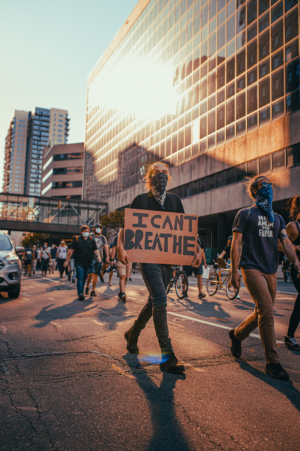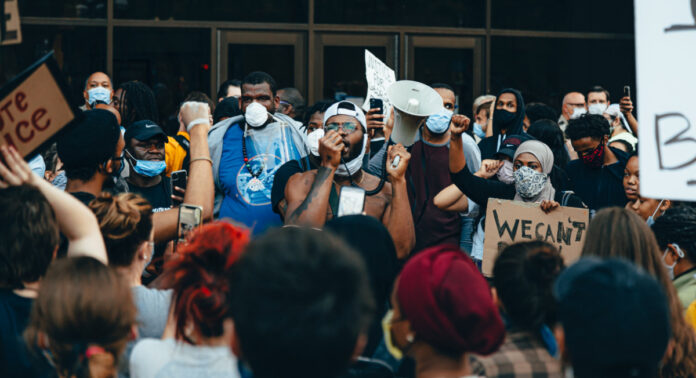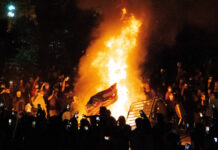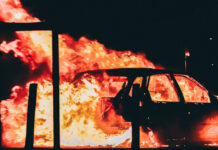Riots and looting across America have knocked coronavirus out of the headlines. This is not a political blog and I want to remain focused on prepping and how to benefit preppers, but as both a prepper and a human, it is impossible to ignore what is happening in Minneapolis, Atlanta, New York, Los Angeles, Philadelphia, and many other cities over the past couple of nights.
I have given my thoughts on the death of George Floyd before and covered how to prepare for civil unrest some time ago, so today will focus on the protests and riots in the context of coronavirus.
Rioting in an Epidemic
From an epidemiological standpoint, these large gatherings of people yelling, chanting and marching are a bad idea. Even though they are outside, the crowds are an ideal mechanism for spreading the virus, just like an outdoor sporting event or concert would be. A couple of superspreaders in the crowd could infect hundreds of people. The only positive thing there is to say is that many of the protesters are young and the majority should not develop serious illnesses. Many infected may be asymptomatic. But if coronavirus numbers shoot up in two or three weeks, it won’t be because someone got an illegal haircut or went to a restaurant.
I think the riots (not the peaceful protests, but the rioting and looting) have been exacerbated by the state of lockdown that persisted for the past 10 weeks. The lockdown built up a vast pool of resentment, anger, and frustration and when there was a focal point, it exploded. You can only lock a country down for so long. Governmental power only takes you so far.
When taken in the context of reopening, the protests and riots just dragged some 40 or more major population centers straight into Phase III. It’s going to be difficult to keep Los Angeles or New York locked down when thousands have already gathered in the street, especially if we don’t see a surge in cases as a result.
The Economics of a Riot
History has shown that most communities that are the site of massive riots like we have seen in Minneapolis suffer the aftereffects for years. Look at South Central and Newark, for example. Yes, there will be some money spent by governments and private parties in the immediate aftermath, but some businesses are going to rebuild elsewhere. Not only are existing businesses going to think twice about rebuilding, but new business are unlikely to move in. That starts a downward spiral of fewer jobs and fewer local services which can lead to the creation of food deserts and increased poverty.

In the past years, we’ve seen a resurgence of urban living, a renaissance as the country’s down towns once again become a cultural center and social focus for Millennials. I have to wonder if the riots on the heels of coronavirus are going to change that.
People leave cities because the feel unsafe. Broken windows, burning police cars, looted stores, and firebombed banks won’t make people feel safe. Suddenly, those suburban homes are going to look more inviting.
Important Lessons
What conclusions can we draw from these protests?
One, if you want to protest, go home before dark. If rioting starts, don’t hang around and watch. I’ve seen video of people loitering on the outskirts of riot who get upset when they are teargassed or shot with rubber bullets. “But we didn’t do anything!” they scream even though they are standing next to someone who did and didn’t leave when instructed to by the police. Rioting is not a spectator sport; you put yourself at risk by being there.
Two, don’t drive through an area where there is or will likely be rioting. (This goes double if you are a trucker, because trucks are having their loads hijacked while they are stuck in traffic.) I don’t know if the idiots we see on TV cruising by are there because they are ignorant or because they are curious, but it’s a good way to get dragged out of it and beaten while they set fire to your car.
Three, if the Memorial Day gatherings last weekend and crowds of protesters this week don’t cause a bunch of COVID-19 cases and increased hospitalizations, then we can probably relax and let our guard down. On the other hand, if cases surge, you can’t say you weren’t warned.
Four, you can only lock people down for so long. We need to start quarantining the sick not the healthy. Lock down our elderly and other vulnerable populations to protect them instead of restricting everyone else. Yes, there is a lot of righteous anger and dismay at how George Floyd was killed, but some of the rioting and looting is by people who are there just to let off some steam (and more of it may be due to agents provocateurs). You cannot lock people into their homes, cut them off from social ties, and prevent people from working without some reaction.
Fifth, democracy is sometime ugly. Protests have a rich history of bringing about change. When peaceful protests fail, rioting is a natural next step. But rioting in front of the state house or governor’s mansion is far more legitimate than rioting inside the Walmart of Target. I have no problem when people want to fight for a worthy cause, but destruction for destruction’s sake or lining your pocket by looting undermines the cause.
Whether you choose to be on the front lines or in the back hills, be careful and don’t be stupid. Stay safe, everyone.
The images accompanying this story are of protests in Minneapolis, Mn., and are by Josh Hild on Unsplash.








